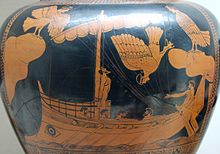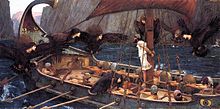- Siren
-
This article is about the mythological creature. For the noise maker, see Siren (noisemaker). For other uses, see Siren (disambiguation).Leucosia redirects here. For the capital city of Cyprus, see Nicosia
Sirens Mythology Greek Grouping Mythological Sub-grouping Avian hybrid Habitat Seagirt meadow Similar creatures Mermaid
Merman
OndineIn Greek mythology, the Sirens (Greek singular: Σειρήν Seirēn; Greek plural: Σειρῆνες Seirēnes) were three dangerous bird-women, portrayed as seductresses who lured nearby sailors with their enchanting music and voices to shipwreck on the rocky coast of their island. Roman poets placed them on an island called Sirenum scopuli. In some later, rationalized traditions, the literal geography of the "flowery" island of Anthemoessa, or Anthemusa,[1] is fixed: sometimes on Cape Pelorum and at others in the islands known as the Sirenuse, near Paestum, or in Capreae.[2] All such locations were surrounded by cliffs and rocks.
When the Sirens were given a parentage they were considered the daughters of the river god Achelous, fathered upon Terpsichore, Melpomene, Sterope, or Chthon (the Earth; in Euripides' Helen 167, Helen in her anguish calls upon "Winged maidens, daughters of the Earth"). Although they lured mariners, for the Greeks the Sirens in their "meadow starred with flowers" were not sea deities. Roman writers linked the Sirens more closely to the sea, as daughters of Phorcys.[3]
Their number is variously reported as between two and five. In the Odyssey, Homer says nothing of their origin or names, but gives the number of the Sirens as two.[4] Later writers mention both their names and number: some state that there were three, Peisinoe, Aglaope, and Thelxiepeia (Tzetzes, ad Lycophron 7l2) or Parthenope, Ligeia, and Leucosia (Eustathius, loc. cit.; Strabo v. §246, 252 ; Servius' commentary on Virgil's Georgics iv. 562); Eustathius (Commentaries §1709) states that they were two, Aglaopheme and Thelxiepeia. Their individual names are variously rendered in the later sources as Thelxiepeia/Thelxiope/Thelxinoe, Molpe, Aglaophonos/Aglaope/Aglaopheme, Pisinoe/Peisinoë/Peisithoe, Parthenope, Ligeia, Leucosia, Raidne, and Teles.
The Sirens of Greek mythology are sometimes portrayed in later folklore as fully aquatic and mermaid-like; the fact that in Spanish, French, Italian, Polish, Romanian and Portuguese the word for mermaid is respectively Sirena, Sirène, Sirena, Syrena, Sirenă and Sereia, and that in biology the Sirenia comprise an order of fully aquatic mammals that includes the dugong and manatee, add to the visual confusion, so that Sirens are even represented as mermaids. However, "the sirens, though they sing to mariners, are not sea-maidens," Harrison had cautioned; "they dwell on an island in a flowery meadow."[5]
Contents
Sirens and death
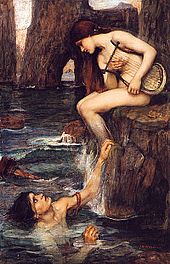 The Siren, by John William Waterhouse (circa 1900), depicted as a fish-chimera.
The Siren, by John William Waterhouse (circa 1900), depicted as a fish-chimera.
According to Ovid (Metamorphoses V, 551), the Sirens were the companions of young Persephone and were given wings by Demeter[6] to search for Persephone when she was abducted. However, the Fabulae of Hyginus rather has Demeter cursing the Sirens for failing to intervene in the abduction of Persephone.
The Sirens might be called the Muses of the lower world, Walter Copland Perry observed: "Their song, though irresistibly sweet, was no less sad than sweet, and lapped both body and soul in a fatal lethargy, the forerunner of death and corruption."[7] Their song is continually calling on Persephone. The term "siren song" refers to an appeal that is hard to resist but that, if heeded, will lead to a bad result. Later writers have inferred that the Sirens were anthropophagous, based on Circe's description of them "lolling there in their meadow, round them heaps of corpses rotting away, rags of skin shriveling on their bones."[8] As Jane Ellen Harrison notes of "The Ker as siren:" "It is strange and beautiful that Homer should make the Sirens appeal to the spirit, not to the flesh."[9] For the matter of the siren song is a promise to Odysseus of mantic truths; with a false promise that he will live to tell them, they sing,
Once he hears to his heart's content, sails on, a wiser man.
We know all the pains that the Greeks and Trojans once endured
on the spreading plain of Troy when the gods willed it so—
all that comes to pass on the fertile earth, we know it all![10]"They are mantic creatures like the Sphinx with whom they have much in common, knowing both the past and the future," Harrison observed. "Their song takes effect at midday, in a windless calm. The end of that song is death."[11] That the sailors' flesh is rotting away, though, would suggest it has not been eaten. It has been suggested that, with their feathers stolen, their divine nature kept them alive, but unable to feed for their visitors, who starved to death by refusing to leave.[12]
According to Hyginus, sirens were fated to live only until the mortals who heard their songs were able to pass by them.[13]
Appearance
Sirens combine women and birds in various ways. In early Greek art Sirens were represented as birds with large women's heads, bird feathers and scaly feet. Later, they were represented as female figures with the legs of birds, with or without wings, playing a variety of musical instruments, especially harps. The tenth century Byzantine encyclopedia Suda[14] says that from their chests up Sirens had the form of sparrows, below they were women, or, alternatively, that they were little birds with women's faces. Birds were chosen because of their beautiful voices. Later Sirens were sometimes depicted as beautiful women, whose bodies, not only their voices, are seductive.
The first century Roman historian Pliny the Elder discounted Sirens as pure fable, "although Dinon, the father of Clearchus, a celebrated writer, asserts that they exist in India, and that they charm men by their song, and, having first lulled them to sleep, tear them to pieces."[15] In his notebooks Leonardo da Vinci wrote of the Siren, "The siren sings so sweetly that she lulls the mariners to sleep; then she climbs upon the ships and kills the sleeping mariners."
In 1917, Franz Kafka wrote in The Silence of the Sirens, "Now the Sirens have a still more fatal weapon than their song, namely their silence. And though admittedly such a thing never happened, it is still conceivable that someone might possibly have escaped from their singing; but from their silence certainly never."
The so-called "Siren of Canosa"[16] accompanied the deceased among grave goods in a burial and seems to have some psychopomp characteristics, guiding the dead on the after-life journey. The cast terracotta figure bears traces of its original white pigment. The woman bears the feet and the wings and tail of a bird. It is conserved in the National Archaeological Museum of Spain, in Madrid.[17]
Encounters with the Sirens
In Argonautica (4.891-919), Jason had been warned by Chiron that Orpheus would be necessary in his journey. When Orpheus heard their voices, he drew out his lyre and played his music more beautifully than they, drowning out their voices. One of the crew, however, the sharp-eared hero Butes, heard the song and leapt into the sea, but he was caught up and carried safely away by the goddess Aphrodite.
Odysseus was curious as to what the Sirens sounded like, so, on Circe's advice, he had all his sailors plug their ears with beeswax and tie him to the mast. He ordered his men to leave him tied tightly to the mast, no matter how much he would beg. When he heard their beautiful song, he ordered the sailors to untie him but they bound him tighter. When they had passed out of earshot, Odysseus demonstrated with his frowns to be released.[18]
Some post-Homeric authors state that the Sirens were fated to die if someone heard their singing and escaped them, and that after Odysseus passed by they therefore flung themselves into the water and perished.[19] It is also said that Hera, queen of the gods, persuaded the Sirens to enter a singing contest with the Muses. The Muses won the competition and then plucked out all of the Sirens' feathers and made crowns out of them.[20] Out of their anguish from losing the competition, writes Stephanus of Byzantium, the Sirens turned white and fell into the sea at Aptera ("featherless") where they formed the islands in the bay that were called Souda (modern Lefkai).[21]
Christian belief
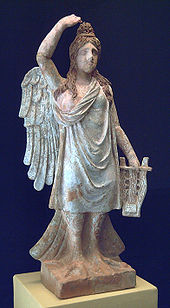 The "Siren" of Canosa
The "Siren" of Canosa
By the fourth century, when pagan beliefs gave way to Christianity, belief in literal sirens was discouraged. Although Jerome, who produced the Latin Vulgate version of the Scriptures, used the word "sirens" to translate Hebrew tenim (jackals) in Isaiah 13:22, and also to translate a word for "owls" in Jeremiah 50:39, this was explained by Ambrose to be a mere symbol or allegory for worldly temptations, and not an endorsement of the Greek myth.[22]
Sirens continued to be used as a symbol for the dangerous temptation embodied by women regularly throughout Christian art of the medieval era; however, in the 17th century, some Jesuit writers began to assert their actual existence, including Cornelius a Lapide, who said of Woman, "her glance is that of the fabled basilisk, her voice a siren's voice—with her voice she enchants, with her beauty she deprives of reason—voice and sight alike deal destruction and death."[23] Antonio de Lorea also argued for their existence, and Athanasius Kircher argued that compartments must have been built for them aboard Noah's Ark.[24]
The Early Christian euhemerist interpretation of mythologized human beings received a long-lasting boost from Isidore's Etymologiae.[25] "They [the Greeks] imagine that 'there were three Sirens, part virgins, part birds,' with wings and claws. 'One of them sang, another played the flute, the third the lyre. They drew sailors, decoyed by song, to shipwreck. According to the truth, however, they were prostitutes who led travelers down to poverty and were said to impose shipwreck on them.' They had wings and claws because Love flies and wounds. They are said to have stayed in the waves because a wave created Venus."
Charles Burney expounded c. 1789, in A General History of Music: "The name, according to Bochart, who derives it from the Phoenician, implies a songstress. Hence it is probable, that in ancient times there may have been excellent singers, but of corrupt morals, on the coast of Sicily, who by seducing voyagers, gave rise to this fable."[26] John Lemprière in his Classical Dictionary (1827) wrote, "Some suppose that the Sirens were a number of lascivious women in Sicily, who prostituted themselves to strangers, and made them forget their pursuits while drowned in unlawful pleasures. The etymology of Bochart, who deduces the name from a Phoenician term denoting a songstress, favours the explanation given of the fable by Damm.[27] This distinguished critic makes the Sirens to have been excellent singers, and divesting the fables respecting them of all their terrific features, he supposes that by the charms of music and song they detained travellers, and made them altogether forgetful of their native land."[28]
Such euhemerist interpretations have been abandoned since the later 19th century, in favour of analyses of Greek mythology in terms of historical Greek social structure and their cultural system, and the Greek taxonomy of the spiritual world.[citation needed]
In the Book of Watchers 19:2-3, supposedly authored by Enoch, great-grandfather of Noah, the women taken as wives by the Grigori of angels became sirens. [29]
See also
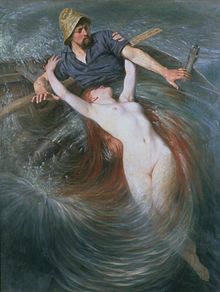 The Fisherman and The Siren, by Knut Ekwall
The Fisherman and The Siren, by Knut Ekwall
- Alkonost
- Ethereal being
- Harpy
- Huldra
- List of avian humanoids
- Lorelei, an area of the Rhine River where fishermen were drawn to their doom by enchanting songs and music
- Melusine
- Moura Encantada
- Naiad
- Nix
- Nymph
- Ondine
- Pincoya
- Sihuanaba
- Sirin
- Slavic fairies
- Syrenka, the Coat of Arms of Warsaw
- Rusalka
- Trauco
- Water sprite
References
- ^ "We must steer clear of the Sirens, their enchanting song, their meadow starred with flowers" is Robert Fagles' rendering of lines in Odyssey XI.
- ^ Strabo i. 22 ; Eustathius of Thessalonica's Homeric commentaries §1709 ; Servius I.e.
- ^ Virgil. V. 846; Ovid XIV, 88.
- ^ Odyssey 12:52
- ^ Harrison 198f.
- ^ Ovid has asked rhetorically, "Whence came these feathers and these feet of birds?" "Ovid's aetiology is of course beside the mark," Jane Ellen Harrison observed; the Keres, the Sphinx and even archaic representations of Athena are winged; so is Eos and some Titans in the Gigantomachy reliefs on the Great Altar of Pergamon; Eros is often winged, and the Erotes.
- ^ Perry, "The sirens in ancient literature and art", in The Nineteenth Century, reprinted in Choice Literature: a monthly magazine (New York) 2 (September–December 1883:163).
- ^ Odyssey 12.45–6, Fagles' translation.
- ^ Harrison 198
- ^ Odyssey 12.188–91, Fagles' translation.
- ^ Harrison 199
- ^ liner notes to Fresh Aire VI by Jim Shey, Classics Department, University of Wisconsin
- ^ Pseudo-Hyginus, Fabulae 141 (trans. Grant) (Roman mythographer C2nd A.D.)
- ^ Suda on-line
- ^ Pliny's Natural History 10:70
- ^ Canosa di Puglia, a site in Apulia that was part of Magna Graecia.
- ^ Image of La Sirena de Canosa
- ^ Odyssey XII, 39
- ^ Hyginus, Fabulae 141; Lycophron, Alexandra 712 ff.
- ^ Lemprière 768.
- ^ Caroline M. Galt, "A marble fragment at Mount Holyoke College from the Cretan city of Aptera", Art and Archaeology 6 (1920:150).
- ^ Ambrose, Exposition of the Christian Faith, Bk 3, Chap. 1, 4
- ^ Longworth, T. Clifton, and Paul Tice (2003). A Survey of Sex & Celibracy in Religion. San Diego: The Book Tree, 61. Originally published as The Devil a Monk Would Be: A Survey of Sex & Celibacy in Religion (1945).
- ^ Carlson, Patricia Ann (ed.) (1986). Literature and Lore of the Sea. Amsterdam: Editions Rodopi, 270
- ^ Grant, Robert McQueen (1999). Early Christians and Animals. London: Routledge, 120. Translation of Isidore, Etymologiae (c. 600-636 A.D.) Book 11, On Man and Portents. Ch. 3: Portents. 30."
- ^ Austern, Linda Phyllis, and Inna Naroditskaya (eds.) (2006). Music of the Sirens. Bloomington, IN: University of Indiana Press, 72
- ^ Damm, perhaps Mythologie der Griechen und Römer (ed. Leveiow). Berlin, 1820.
- ^ Lemprière 768. Brackets in the original.
- ^ Enoch [http://www.ancienttexts.org/library/ethiopian/enoch/1watchers/watchers.htm "Watchers"
Bibliography
- Harrison, Jane Ellen (1922) (3rd ed.) Prolegomena to the Study of Greek Religion. London: C.J. Clay and Sons.
- Homer, The Odyssey
- Lemprière, John (1827) (6th ed.). A Classical Dictionary;.... New York: Evert Duyckinck, Collins & Co., Collins & Hannay, G. & C. Carvill, and O. A. Roorbach.
Further reading
- Siegfried de Rachewiltz, De Sirenibus: An Inquiry into Sirens from Homer to Shakespeare, 1987: chs: "Some notes on posthomeric sirens; Christian sirens; Boccaccio's siren and her legacy; The Sirens' mirror; The siren as emblem the emblem as siren; Shakespeare's siren tears; brief survey of siren scholarship; the siren in folklore; bibliography"
External links
- Theoi Project, Seirenes the Sirens in classical literature and art
- The Suda (Byzantine Encyclopedia) on the Sirens
Dacia topics Dacian tribes: Aedi · Albocense · Anartes · Apuli · Artakioi · Biephi · Biessoi · Buri · Carpi · Cauci · Ciaginsi · Clariae · Costoboci · Cotini · Crobidae · Daci · Getae · Moesi · Osi · Peukini · Piephigi · Potulatense · Predasense · Rhadacense · Saldense · Scaugdae · Sense · Suci · Terizi · Teurisci · Trixae · Tyragetae · Troglodytae
Dacian kings: Culture and civilisation: Art, jewellery, treasures, tools (Bracelets) · Clothing · Foreign Relations (Greeks · Celts · Romans · Germanic tribes) · Warfare (Falx · Sica · Thracian warfare)
Sarmizegetusa · Argidava · Buridava · Cumidava · Piroboridava · Sucidava · More towns... · Davae · Dacian Fortresses of the Orăştie Mountains · Murus dacicusWars with the
Roman Empire:Roman Dacia: Dacia Traiana · Moesia · Scythia Minor · Dacia Aureliana · Diocese of Dacia · Dacia Mediterranea · Dacia Ripensis · Trajan (Bridge · Column) · Towns and cities · Castra · Limes (Alutanus · Moesiae · Porolissensis · Sarmatiae · Transalutanus · Trajan's Wall · Brazda lui Novac) · Language (Thraco-Roman · Eastern Romance substratum)Research on Dacia: Books about Dacia · Dacian archaeology · Archaeological sites in Romania · Dacology · Thracology · ProtochronismWikiProject • Commons • Dacian fortresses, settlements, Roman castra, limes from Romania: Google Maps • Google EarthCategories:- Characters in the Odyssey
- Greek mythology
- Greek legendary creatures
- Legendary creatures in popular culture
- Mythic humanoids
- Music in Greek mythology
- Mythological hybrids
- Water spirits
Wikimedia Foundation. 2010.


